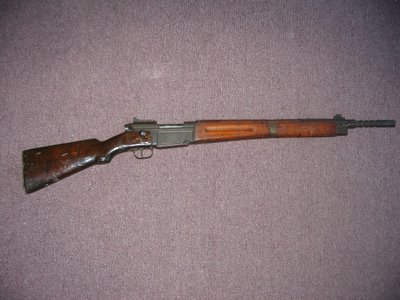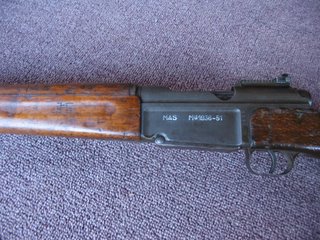
The dealer who had it for sale says that he got it from a long-time customer who is a Vietnam vet and this rifle is one that the vet brought back from that country. A French rifle from Vietnam? That's easy. Vietnam was a French colony before the Viet Minh rose up and (with much Communist help) defeated the French in 1954. OK it wasn't a defeat as much as it was a serious bitch-slapping of the first order at a place called Dien Bien Phu. The French basically bottled themselves up in a large base camp in a topographical bowl and then let the Vietnamese emplace artillery all around them which the Viets then fired down on them 24 hours a day for over 200 days. And rather than doing something smart--like leaving--the French continued to send in more troops right up to the very end, when over 10,000 of them had to surrender to the Viet Minh. Naturally the French left behind thousands of rifles, pistols, machine guns and other small arms which were then taken up by the Vietnamese and used against US forces when we arrived shortly thereafter.
Now who in the French military might have used a MAS 36-51? This is a bolt-action rifle and it had been replaced in front-line service by the semi-automatic MAS 49 and MAS 49-56. Older bolt guns like the 36-51 would have been relegated to indigenous conscripts (Vietnamese, Laotian and Cambodian fighters) Colonial troops from other French colonies in Africa, and the Foreign Legion, which was composed of mainly European soldiers-of-fortune fighting under the French flag. Notably many of these men in the 1950's were ex-Nazis that were either originally conscripted at the end of WW2 or who subsequently volunteered in an effort to find a place to hide out from war crimes tribunals while doing what they knew best how to do--fight.
 This particular rifle could rightfully have belonged to any one of the latter categories of soldier. However on inspection, there are what appear to be two initials in the left lower stock piece, and they are not Asian or African symbols but the letters "JG". More than likely it was a European who put those there and that would suggest that this rifle probably belonged to a Legionaire.
This particular rifle could rightfully have belonged to any one of the latter categories of soldier. However on inspection, there are what appear to be two initials in the left lower stock piece, and they are not Asian or African symbols but the letters "JG". More than likely it was a European who put those there and that would suggest that this rifle probably belonged to a Legionaire.The rifle is not one of the recently-imported guns that flooded the market a few years ago. Those were pretty much in excellent shape and this gun is frankly beat to hell. It does not have an importation stamp on it as any one of the imports would, and it's a toal mis-match in that at one time or another, the bolt, magazine floorplate, and stock were all replaced in the field with parts originally serial-numbered to other rifles. The bore is dark with just a few tiny pits and the lands and grooves are worn in that way that a heavily-shot rifle's barrel wears over time. The parkerized finish wore off long ago and the wood shows evidence of much handling. This thing's been around the block more than a few times. Unfortunately the bayonet is missing but with a little luck I'm sure I can turn one up for it.
Ammunition's another thing. The French have this annoying habit of developing proprietary cartridges for their rifles and their rifles only. So the 7.5mm cartridge that I need isn't nearly as easy to find--or as cheap--as the more common NATO and Communist-bloc surplus ammunition is. But I'll eventually find and buy a few hundred rounds of the stuff just so I can shoot this museum-piece a few times.
 Overall, this gun's ragged but it's still apparently very well-constructed. It's solid and the machining and welding were once done and finished quite professionally. The sights are robust and the rear elevation still moves freely. The whole grenade-launching apparatus on the front end still moves as it should and it's tight, with no slop or play. The bolt moves sharply and more smoothly that I would have expected, even with all the wear, and the trigger pull is heavy but still seems somewhat crisp and consistent.
Overall, this gun's ragged but it's still apparently very well-constructed. It's solid and the machining and welding were once done and finished quite professionally. The sights are robust and the rear elevation still moves freely. The whole grenade-launching apparatus on the front end still moves as it should and it's tight, with no slop or play. The bolt moves sharply and more smoothly that I would have expected, even with all the wear, and the trigger pull is heavy but still seems somewhat crisp and consistent.Like I said, I've never seen a MAS in this condition before. The French aren't exactly known for using military arms much and the ones they do use tend to show more evidence of being dropped than shot. This one's clearly got some history behind it and if guns could talk, I'll bet it could tell some stories. So I bought it for it's history and the questions it poses and it now has a place in my rack second one from the right in between the Mausers and the lone Japanese Type 99 that I have.

Nice! Worn just means character.
ReplyDeleteThis would be the same French who, when told repeatedly that the Kaiser would come at them through Belgium refused to believe it until the Kaiser invaded through Belgium? And the same French who thought the Manginot Line was sufficient to stop the Nazis? The whole fiasco at Dien Bien Phu isn't surprising.